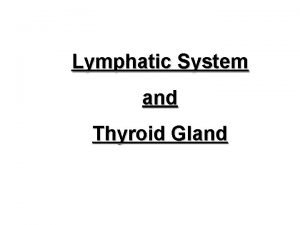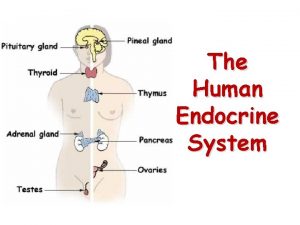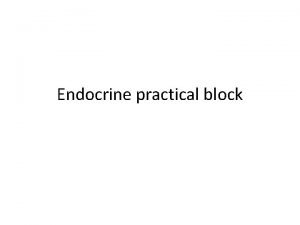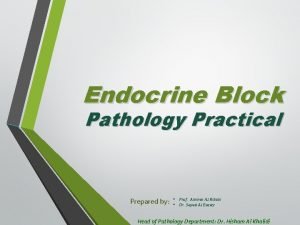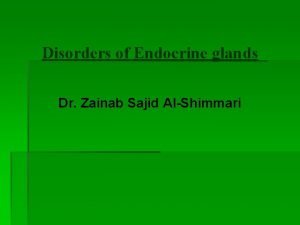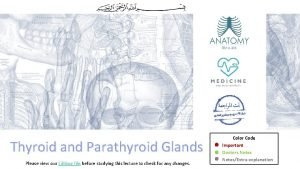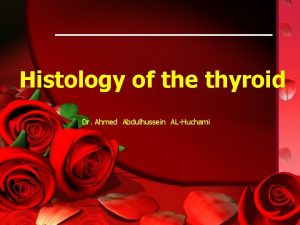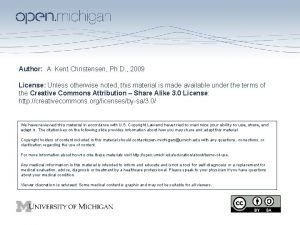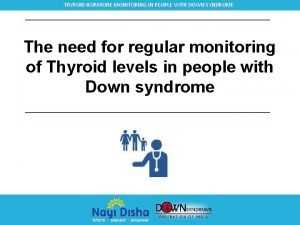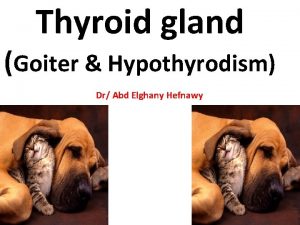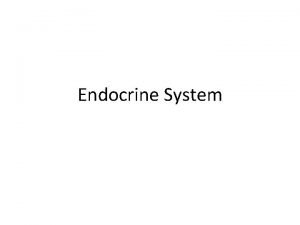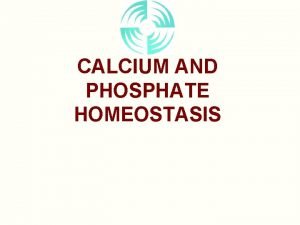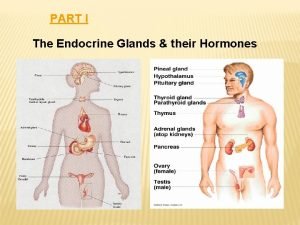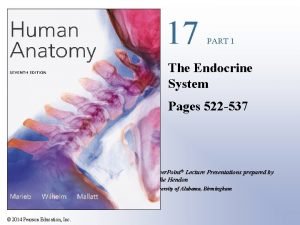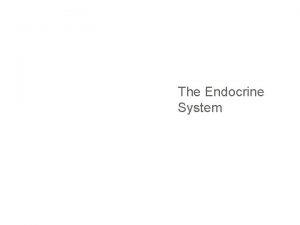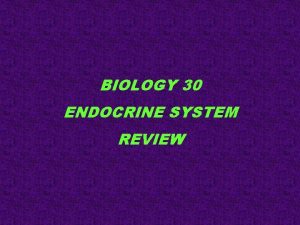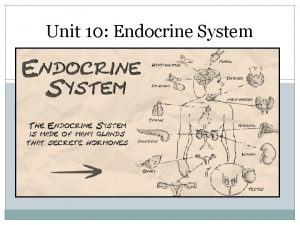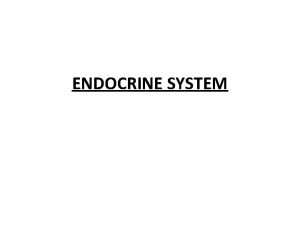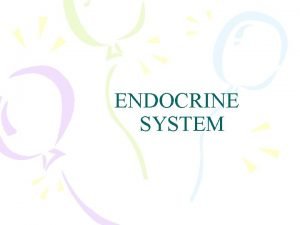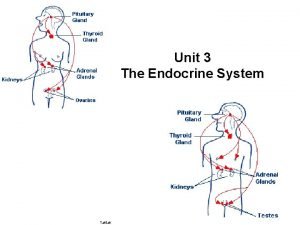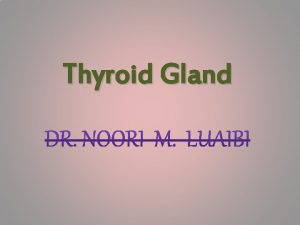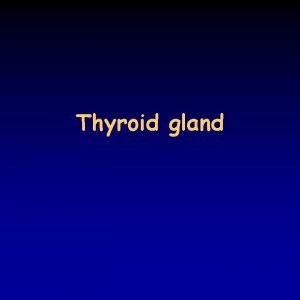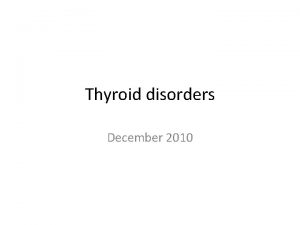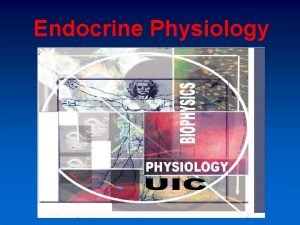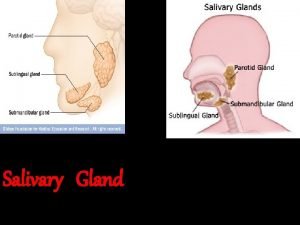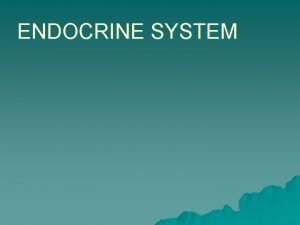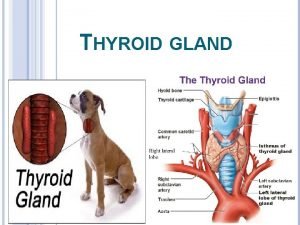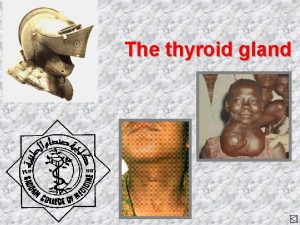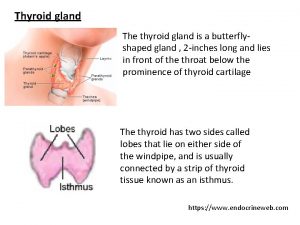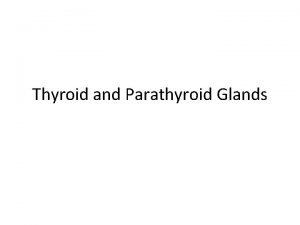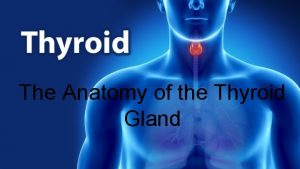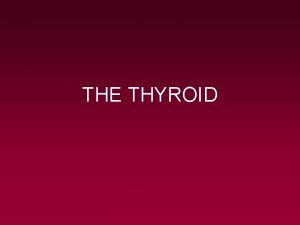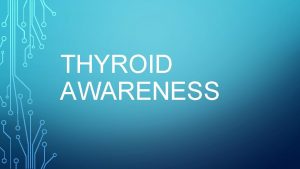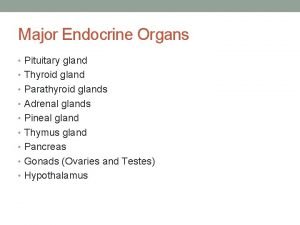Endocrine system lectures 23 Thyroid gland Dr Heyam
















































- Slides: 48

Endocrine system lectures 2&3 Thyroid gland Dr Heyam Awad FRCPath

Diseases of thyroid gland Same general rule of all endocrine glands! • Mass effect • Hyperthyroidism ( thyrotoxicosis) • Hypothyroidism • Again, there is no relation between mass effect and level of hormonal production

Thyroid diseases Mass effect: • Thyroiditis: inflammation that causes enlargement of the gland. • Graves disease • Diffuse nontoxic goiter and multinodular goiter • neoplasms

Clinical manifestations of thyrotoxicosis a. Constitutional symptoms : warm flushed skin, heat intolerance and excessive sweating , weight loss despite increased appetite. b. Malabsorption, and diarrhea ( because of increased intestinal motility) c. Tachycardia and elderly patients may develop heart failure due to aggravation of pre-existing heart disease d. Nervousness, tremor, and irritability. e. A wide, staring gaze and lid lag because of sympathetic overstimulation of the levator palpebrae superioris f. 50% develop proximal muscle weakness (thyroid myopathy). g. Thyroid storm. . See next

Thyroid storm • Abrupt onset of severe hyperthyroidism, and this condition occurs most commonly in individuals with Graves disease and it is a medical emergency because significant numbers of untreated patients die of cardiac arrhythmias • Usually occurs in untreated or undertreated people

Lab tests • The measurement of serum TSH is the most useful single screening test for hyperthyroidism, because TSH levels are decreased even at the earliest stages, when the disease may still be subclinical

- Once the diagnosis of thyrotoxicosis has been confirmed measurement of radioactive iodine uptake by the thyroid gland often is valuable in determining the etiology

Iodine scans. . Black color shows how much iodine is the gland is taking. . More iodine means more activity in producing hormones

HYPOTHYROIDISM : a. - Worldwide, the most common cause of hypothyroidism is dietary deficiency of iodine. b. In most developed countries, autoimmune diseases predominate such as Hashimoto thyroiditis

hypothyroidism It causes: • Cretinism. . Hypothyroidism in infancy and early childhood • Myxedema… hypothyroidism in older children and adults

Myxedema. or Gull syndrome : a. cold intolerance and obesity b. Generalized apathy and mental sluggishness that in the early stages of disease may mimic depression c. Broadening and coarsening of facial features d. Enlargement of the tongue, and deepening of the voice. e. Bowel motility is decreased, resulting in constipation. f. Pericardial effusions are common; in later stages, the heart is enlarged, and heart failure may supervene. g. Mucopolysaccharide-rich edematous fluid accumulates in skin, subcutaneous tissue, and number of visceral sites

Lab tests Serum TSH is the most sensitive screening test. a. The serum TSH is increased in primary hypothyroidism b. The TSH is not increased in persons with hypothyroidism caused by primary hypothalamic or pituitary disease. c. Serum T 4 is decreased hypothyroidism of any origin.

thyroiditis • = inflammation of the thyroid gland • Several types: • 1. Chronic Lymphocytic (Hashimoto) Thyroiditis • 2. Subacute Granulomatous (de Quervain) Thyroiditis • 3. Subacute Lymphocytic Thyroiditis • 4. Riedel thyroiditis

Chronic Lymphocytic (Hashimoto) Thyroiditis - Is the most common cause of hypothyroidism in areas of the world where iodine levels are sufficient. - It is characterized by gradual thyroid failure secondary to autoimmune destruction of the thyroid gland - It is most prevalent between the ages of 45 and 65 years and is more common in women than in men *NOTE: ALL THYROID DISEASES ARE MORE IN WOMEN - It can occur in children and is a major cause of nonendemic goiter in children - There is genetic predisposition

• Gross : - Diffuse and symmetric enlargement of the thyroid but localized enlargement may be seen in some cases to raise suspicion for neoplasm Microscopic examination reveals 1. Infiltration by small lymphocytes, plasma cells, and well-developed germinal centers 2. The thyroid follicles are atrophic 3. Some follicles are lined by epithelial cells with abundant eosinophilic, cytoplasm, termed Hürthle cells and these Hurthle cells have numerous mitochondria

- Clinically , 1. Painless thyroid enlargement associated with some degree of hypothyroidism, 2. - In the usual clinical course, hypothyroidism develops gradually. ; however, it may be preceded by transient thyrotoxicosis due to disruption of thyroid follicles , and secondary release of thyroid hormones (hashitoxicosis). SO: at the beginning of the disease the destruction by autoimmune antibodies might cause increased release of thyroid hormones from the destructed follicles but later there is so much destruction and no new colloid is formed, resulting in hypothyroidism

Hashimoto

Hurthle cells: large cells with abundant eosinophilic cytoplasm, due to increased mitochondria

- Patients with Hashimoto thyroiditis often : 1. Have other autoimmune diseases 2. . Are at increased risk for the development of B cell non-Hodgkin lymphomas within the thyroid gland.

Subacute Granulomatous (de Quervain) Thyroiditis - Is much less common than Hashimoto disease - - More frequently in women than in men. - Is believed to be caused by a viral infection and a majority of patients have a history of an upper respiratory infection just before the onset of thyroiditis. - Histology: granulomas - It is self limited.

GRAVES DISEASE The most common cause of endogenous hyperthyroidism with a peak incidence in women between the ages of 20 and 40. Triad of manifestations: A. Thyrotoxicosis, All patients B. Localized, infiltrative dermopathy ( pretibial myxedema), minority of cases and involves the skin overlying the shins, and manifests as scaly thickening C. Infiltrative ophthalmopathy with resultant exophthalmos in 40% of patients

PATHOGENESIS : - Genetic factors - it is characterized by a breakdown in self-tolerance to thyroid autoantigens, and is the production of multiple autoantibodies

Autoantibodies in GRAVES : 1. Thyroid-stimulating immunoglobulin: - An Ig. G antibody binds to the TSH receptor and mimics the action of TSH, with resultant increased hormones 2. Thyroid growth-stimulating immunoglobulins: - Directed against the TSH receptor, and have been implicated in the proliferation of follicular epithelium 3. TSH-binding inhibitor immunoglobulins: - Prevent TSH from binding to its receptor on thyroid cells and in so doing may actually inhibit thyroid cell function, a finding explains why some patients with Graves spontaneously develop episodes of hypothyroidism.

Laboratory findings and radiologic findings - Elevated serum free T 4 and T 3 and depressed serum TSH - Because of ongoing stimulation of the thyroid follicles radioactive iodine uptake is increased, and radioiodine scans show a diffuse uptake of iodine.

DIFFUSE AND MULTINODULAR GOITER - Enlargement of the thyroid, or goiter, is the most common manifestation of thyroid disease Mechanism : - The goiters reflect impaired synthesis of thyroid hormone often caused by dietary iodine deficiency and this leads to to a compensatory rise in the serum TSH, which in turn causes hyperplasia of the follicular cells and, ultimately, gross enlargement of the thyroid gland. ,

Goiters can be endemic or sporadic. Endemic goiter : Occurs in geographic areas where the soil, water, and food supply contain little iodine. - The term endemic is used when goiters are present in more than 10% of the population in a given region. -

Sporadic goiter : Less common than endemic goiter. - The condition is more common in females than in males, with a peak incidence in puberty or young adulthood, when there is an increased physiologic demand for T 4. - It may be caused by several conditions, including the: a. Ingestion of substances that interfere with thyroid hormone synthesis , such as excessive calcium and vegetables such as cabbage, cauliflower, sprouts, . b. Hereditary enzymatic defects that interfere with thyroid hormone synthesis (dyshormonogenetic goiter). -In most cases, the cause of sporadic goiter is not apparent.

- Multinodular goiters cause multilobulated, asymmetrically enlarged glands which attain massive size and old lesions often show fibrosis, hemorrhage, calcification - Multinodular goiters typically are hormonally silent, - 10% of patients can manifest with thyrotoxicosis due to the development of autonomous nodules producing hormone independent of TSH stimulation and this condition, called toxic multinodular goiter or Plummer syndrome

Thyroid tumors : -present as solitary nodules. - the majority of solitary nodules of the thyroid prove to be benign : a. Follicular adenomas b. A dominant nodule in multinodular goiter c. Simple cysts or foci of thyroiditis - Carcinomas of the thyroid, are uncommon, accounting for much less than 10% of solitary thyroid nodules.

Follicular adenomas - Are benign neoplasms derived from follicular epithelium. - solitary. - The tumor is demarcated and compressed the adjacent thyroid parenchyma by a well-defined, intact capsule - - cold nodules on scanning but might be functional.

. Microscopic examination of follicular adenoma, - The cells are arranged in follicles and its variants a. Hurthle cell adenoma: - The neoplastic cells show oxyphil or Hürthle cell change) and its behavior is not different from those of a conventional adenoma. b. Atypical adenoma: The neoplastic cells exhibit focal nuclear atypia, (endocrine atypia); and these features do not constitute evidence of malignancy **NOTE: endocrine atypia can occur in any benign neoplasm of any endocrine gand.

Follicular adenoma

Endocrine atypia • Note these large and pleomorphic cells in a thyroid adenoma. This is endocrine atypia that doesn't necessarily mean the lesion is malignant

- Thyroid adenomas : a. Carry an excellent prognosis b. and do not recur or metastasize c. and are not forerunners to carcinomas ( not premalignant)

Carcinomas : - Accounting for about 1. 5% of all cancers - A female predominance has been noted among patients who develop thyroid carcinoma in the early and middle adult years -cases manifesting in childhood and late adult life are distributed equally between men and women - The major subtypes of thyroid carcinoma are 1. Papillary carcinoma ( for more than 85% of cases) 2. Follicular carcinoma (5% to 15% of cases) 3. Anaplastic carcinoma (less than 5% of cases) 4. Medullary carcinoma (5% of cases)

Environmental Factors. a. The major risk factor to papillary thyroid cancer is exposure to ionizing radiation, during the first 2 decades of life. b. Deficiency of dietary iodine: and by extension, an association with goiter is linked with a higher frequency of follicular carcinomas.

Papillary Carcinoma : Is the most common form - accounts for the majority of thyroid carcinomas associated with previous exposure to ionizing radiation. - May occur at any age,

Microscopically: . 1. The nuclei of papillary carcinoma cells show: a. optically clear nuclei, or "Orphan Annie eye" nuclei , seen on histological but not cytological preparations ( formalin artefact) b. Have invaginations of the cytoplasm to the nucleus ( pseudoinclusions) 2. papillary architecture is common 3. Concentrically calcified structures (psammoma bodies) 5. Metastases to cervical lymph nodes in half of cases.

Papillary carcinoma

Orphan Annie eye! Because the nuclei are white and empty like Annie’s character eyes!!

Psammoma bodies: calcification arranged in concentric pattern

Clinical Features of papillary carcinomas a. nonfunctional tumors manifest as painless masses in the neck, either within the thyroid or as metastasis in a cervical lymph node b. indolent lesions, with 10 -year survival rates of 95%. c. The presence of isolated cervical nodal metastases does not have influence on good prognosis of these lesions. d. In a minority of patients, hematogenous metastases are present at the time of diagnosis, most commonly to lung.

Follicular Carcinoma : -- More common in women and in areas with dietary iodine deficiency. - The peak incidence between the ages of 40 and 60 years On microscopic examination, to diagnose follicular carcinoma you need • Capsular invasion • Or vascular invasion - requires extensive histologic sampling to find capsular and/or vascular invasion

Clinical Features - Manifest most frequently as solitary cold thyroid nodules. - Tend to metastasize through the bloodstream (hematogenous dissemination) to lungs, bone, and liver. - Regional nodal metastases are uncommon. NOTE HOW THE ABOVE TWO FEATURES DIFFER FROM PAPILLARY CARCINOMA !! - As many as half of patients with widely invasive carcinomas succumb to their disease within 10 years, while less than 10% of patients with minimally invasive follicular carcinomas die within the same time span.

3. Anaplastic Carcinoma - undifferentiated tumors, - The mean age of 65 years. - They are aggressive, with a mortality rate of 100%. - Metastases to distant sites are common, but death occurs in less than 1 year as a result of aggressive local growth which compromise of vital structures in the neck.

4. Medullary Carcinoma - neuroendocrine neoplasms. - Secrete calcitonin, the measurement of which plays an important role in the diagnosis and postoperative follow-up evaluation of patients. -

- The sporadic cases manifests most often as a mass in the neck, sometimes associated with compression effects such as dysphagia or hoarseness. - AMYLOID STAIN IS POSITIVE IN THESE TUMORS= congo red stain

Medullary carcinoma
 Is thyroid a lymphatic organ
Is thyroid a lymphatic organ Estrogen effect
Estrogen effect Secretory gland
Secretory gland Pheochromocytoma
Pheochromocytoma Papillary thyroid carcinoma gross
Papillary thyroid carcinoma gross Nodular goiter
Nodular goiter Berry's ligament thyroid
Berry's ligament thyroid Nerve supply of parathyroid gland
Nerve supply of parathyroid gland Principal cells location
Principal cells location Follicular cells of thyroid gland
Follicular cells of thyroid gland Thyroid parafollicular cells
Thyroid parafollicular cells Thyroid hormones
Thyroid hormones Pituitary hormones and their targets
Pituitary hormones and their targets Pathology
Pathology Pituitary gland thyroid
Pituitary gland thyroid Swollen thyroid
Swollen thyroid Dog thyroid gland
Dog thyroid gland Thyroid face
Thyroid face Four oval masses on posterior thyroid gland
Four oval masses on posterior thyroid gland Pituitary gland and pineal gland spiritual
Pituitary gland and pineal gland spiritual Thyoid gland
Thyoid gland Endocrine system and reproductive system
Endocrine system and reproductive system Endocrine system vs nervous system
Endocrine system vs nervous system Lympathic
Lympathic General mechanism of hormone action
General mechanism of hormone action Adh function
Adh function Power system lectures
Power system lectures Chapter 16 matching questions 1-5
Chapter 16 matching questions 1-5 Parts of the endocrine system
Parts of the endocrine system Differences between nervous system and endocrine
Differences between nervous system and endocrine Comparison of endocrine and nervous system
Comparison of endocrine and nervous system Steroids endocrine system
Steroids endocrine system Endocrine system fact
Endocrine system fact External anatomy of rat
External anatomy of rat A hormone
A hormone Endocrine system pearson
Endocrine system pearson Exocrine glands are ductless
Exocrine glands are ductless 7:13 endocrine system
7:13 endocrine system Mammillary body
Mammillary body Stimulus humoral
Stimulus humoral Hypothal
Hypothal Biology 30 endocrine system
Biology 30 endocrine system Site:slidetodoc.com
Site:slidetodoc.com Chapter 23 the endocrine system
Chapter 23 the endocrine system Endocrine system analogy
Endocrine system analogy The endocrine system consists of
The endocrine system consists of Endocrine system abbreviations
Endocrine system abbreviations T4.taktak
T4.taktak Endocrine system
Endocrine system
